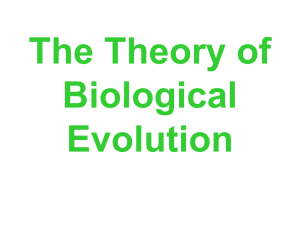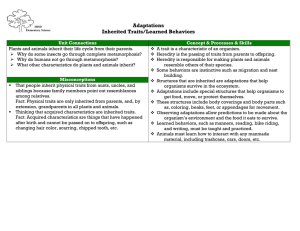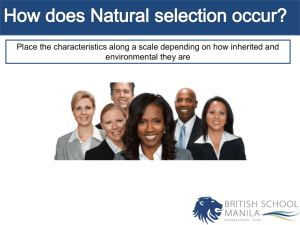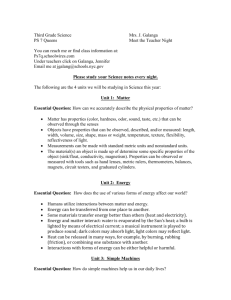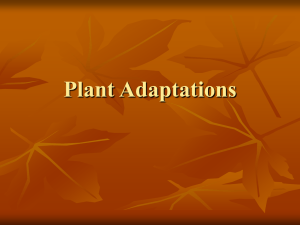Heredity and Evolution Study Guide Answer Key doc
advertisement
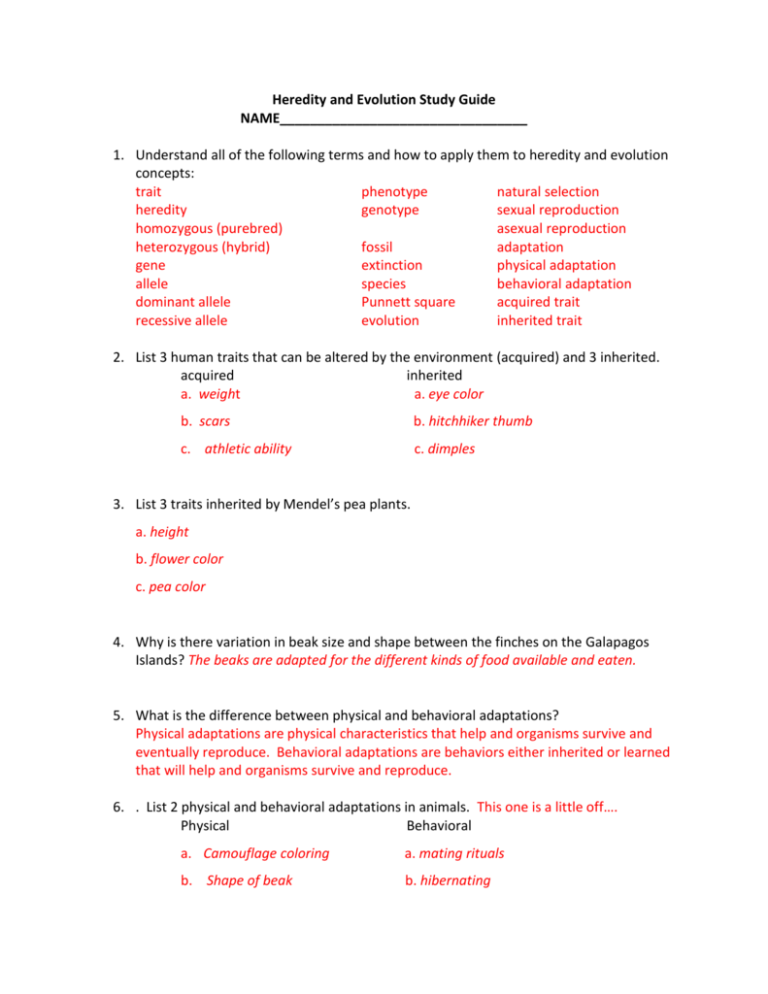
Heredity and Evolution Study Guide NAME_________________________________ 1. Understand all of the following terms and how to apply them to heredity and evolution concepts: trait phenotype natural selection heredity genotype sexual reproduction homozygous (purebred) asexual reproduction heterozygous (hybrid) fossil adaptation gene extinction physical adaptation allele species behavioral adaptation dominant allele Punnett square acquired trait recessive allele evolution inherited trait 2. List 3 human traits that can be altered by the environment (acquired) and 3 inherited. acquired inherited a. weight a. eye color b. scars b. hitchhiker thumb c. athletic ability c. dimples 3. List 3 traits inherited by Mendel’s pea plants. a. height b. flower color c. pea color 4. Why is there variation in beak size and shape between the finches on the Galapagos Islands? The beaks are adapted for the different kinds of food available and eaten. 5. What is the difference between physical and behavioral adaptations? Physical adaptations are physical characteristics that help and organisms survive and eventually reproduce. Behavioral adaptations are behaviors either inherited or learned that will help and organisms survive and reproduce. 6. . List 2 physical and behavioral adaptations in animals. This one is a little off…. Physical Behavioral a. Camouflage coloring a. mating rituals b. Shape of beak b. hibernating 7. Define common ancestor. A species from an earlier time that are related to several other species. Evidence for this is found through the fossil record, similarities in DNA, homologous structures and similarities in early development. 8. What kind of evidence to fossils provide? They are a history of life in the geologic past. 9. What shows similarities among species both past and present? a. fossil record b. similarities in early development c. homologous structures d. similarities in DNA 10. Because of global warming, there is concern for Arctic fox survival. What adaptations may help some the Arctic fox survive warmer temperatures? (possible responses) Some may have darker fur to blend in with environments lacking snow and ice. Some may have less dense fur which does not trap as much heat. Some may have a smaller body size so it doesn’t retain as much heat. 11. What can happen to a species of it doesn’t have helpful adaptations to a major change in the environment? The species may go extinct. 12. What is the difference between a learned behavior and an inherited behavior? Which can be passed to offspring and why? Learned behaviors are ones an organism has gained by interacting with its environment. Inherited behaviors are instinctive and passed on through genes. Only inherited behavior is passed to offspring because they are genetic. 13. SpongeBob is known for his big round eyes (R), which is dominant over an oval eye shape (r). If he is heterozygous for his round eye shape and marries a woman with oval eye shape, what type of eyes might the kids have? A. List the genotypes for each: Heterozygous round eyes - __Rr_____ Oval eyes - __rr_____ B. Complete the Punnett square to show the possibilities that would result if SpongeBob had children with an oval-eyed woman. R r r Rr rr r Rr rr C. List the possible genotypes and phenotypes for their children. Rr round and rr oval D. What are the chances of a child with a round eye shape? _50___% What are the chances of a child with an oval eye shape? __50__% 14. What are 3 catastrophic events causing mass extinctions of several species? (possibilities) a. asteroid hit b. volcanic eruptions/earthquakes c. change in sea level, change in climate/temperature 15. Darwin’s Theory evolution is called natural selection and give an example. The process by which organisms that are best adapted to their environment are most likely to survive and reproduce. OR Organisms with adaptations for surviving their environment survive and pass those traits on to the offspring. Examples: finch beaks on the Galapagos Islands. The lengthening of a giraffe’s neck. 16. Why are there similarities between South American and Galapagos iguanas? What is the reason for the differences? It’s likely the Galapagos iguanas were originally from South America. That is why there are similarities. The differences are due to the differences in environment. Each type of iguana has adaptations for survival where they live. 17. What are 2 advantages to both sexual and asexual reproduction? Sexual Asexual a. Genetic variation a. no need to find a mate b. Better chance for survival if b. reproduce more quickly change in environment 18. What is the genetic difference between offspring produced asexually and those produced sexually? There is genetic variation in those produced sexually. Asexually reproduced offspring are identical (clone) to the parent. 19. What is the purpose of inference? How do scientists use it to describe change over time? Inferences use evidence and knowledge to come to a conclusion. Scientists use fossilized evidence to infer what life and organisms were like in the past. 20. How might it be possible for a new species evolve from the original population? When a group of organisms is separated from the original species, individuals with the best adaptations will survive and pass those traits on to the next generations. Over time, the new group may become different enough that they are no longer able to successfully reproduce with the original population. 21. What are homologous structures? List a group of animals that have them. Explain how homologous structures provide evidence of evolution? Similar structures that related species have inherited from a common ancestor, but changed over time. A dolphin, a dog, and a seagull If animals share homologous (similar) structures they may have evolved from a common ancestor. 22. A farmer in Iowa and a farmer in Michigan are planting corn. How could you explain whether differences in corn growth are because of genetics or the environment? (Sample answer) A Michigan corn seed can be planted in Iowa and an Iowa corn seed can be planted in Michigan. If plants grow to match the plants in the new area, the differences are environment. If the plants grow to match plants in the original place, the differences are genetic.


